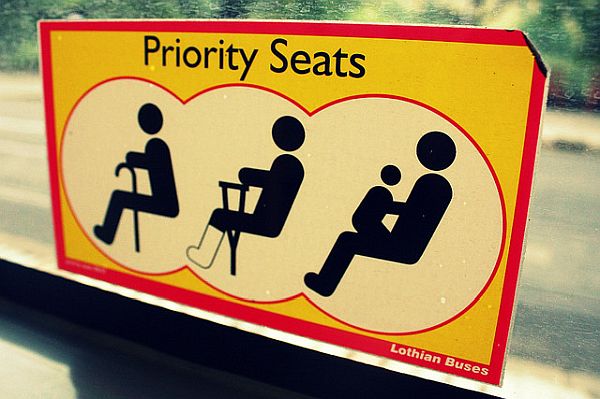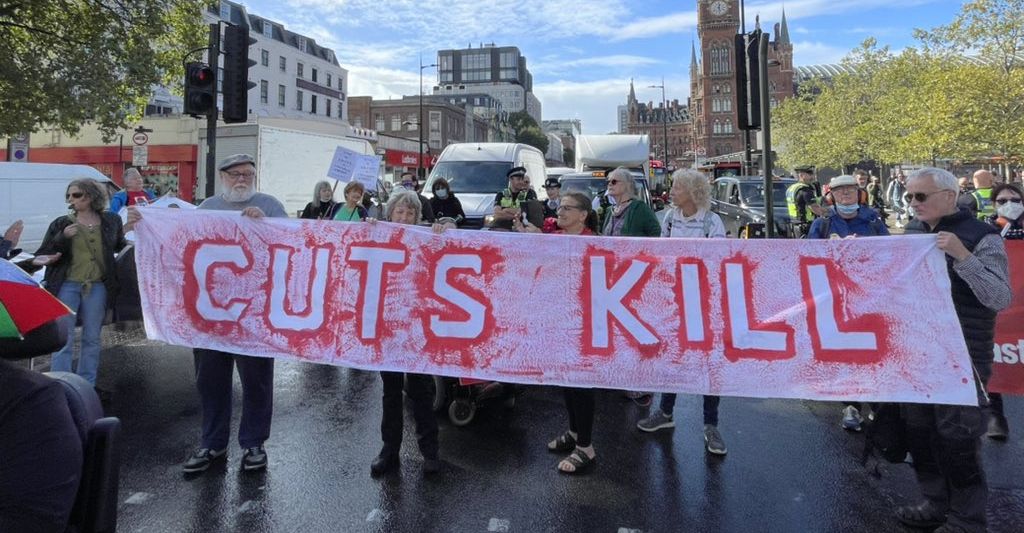On a recent, hot afternoon, I fainted after having to stand on a tram again. On my way to the city, the 58 tram was packed with bodies pressed against each other and the sun-warmed windows and doors. I clutched onto the handrail, anxiously surveying the tram for a seat to become available.
When people see me standing, they see a healthy, able-bodied, 20-something-year-old who probably doesn’t need a seat. What they don’t see are the four medications I take just to be able to get out of bed, or the compression garments under my clothing to help prevent blood-pooling, or my bodily systems malfunctioning internally.
I have an autonomic nervous system disorder whereby my blood vessels don’t narrow the way they’re supposed to when I’m standing, causing a drop in the blood supply to my heart and brain. My heart hammers away and my blood pressure falls. Breathing becomes difficult. I’ve learned blood flow-promoting counter-maneuvers in order to stand for short periods, but they’re hard to do in confined spaces like overcrowded trams, and they don’t always work.
By the time the tram reached Royal Park, I was struggling to keep upright. Out the window, tall eucalyptuses swam in and out of vision, the green air whirling and vertiginous, mottled with white spots. When I tried to attract the attention of two teenagers sat on the priority seat metres away, they looked away. I stumbled off at the next tram stop and fainted on a dry square of grass by the road. People walked by my body. When I could lift my phone, I sent a text to cancel my plans and ordered an Uber to take me back home. I lay in the backseat, apologising to the driver who thought I was drunk.
*
The social model of disability, compared to the widely-used medical model, would say it’s not my body’s orthostatic intolerance or wonky blood vessels that cause my disability, but the fact that the social structures in place mean I don’t have easy access to a seat when I need one.
The few priority seats on our public transport show symbols of a person in a wheelchair, a person with a mobility aid, an elderly person and a pregnant person. Because I don’t fit any of these categories, I feel nervous asking for a seat. I worry about coming across as unduly entitled or that someone else might need it more. And when I work up the guts to ask, my request is met with rude stares, invasive questions, or flat-out refusals, because I don’t look sick, or because, ‘well, we all want a seat, love.’
If people keep being taught that disability only looks a certain way, why would they believe otherwise? But many invisible conditions impact a person’s ability to stand for extended periods such as Multiple Sclerosis, Myalgic Encephalomyelitis/Chronic Fatigue Syndrome, Lyme disease, Lupus, people with brain injuries, people undergoing cancer treatments and many more.
Of the four million people in Australia who have some form of disability, only 14.9% use a mobility aid, and only 4.4% use a wheelchair. It’s currently estimated that at least 90% of disabilities are invisible. Yet we still judge and treat disability as something easily ascertained by looking at someone, and disabled people are routinely abused when they exit accessible bathrooms or walk away from disabled car parks.
This is why I’m too scared to use the disability parking permit I’ve been recommended, opting instead for a chronic pain flare-up after shopping for food on a bad day. It’s what keeps me passing out at gigs, in waiting lines and on the side of the road.
Because my conditions are invisible – I have also been diagnosed with Myalgic Encephalomyelitis (also known as Chronic Fatigue Syndrome) and a chronic pain condition called Fibromyalgia – I simultaneously experience the privilege of being able to move through the world being read as able-bodied, and therefore copping less abuse than many visibly disabled people do, while also having the disadvantage of my needs and access requirements being invisible and therefore denied.
That’s not to say people with visible disabilities aren’t having their needs and access requirements routinely ignored and denied, of course.
By law, 90% of Melbourne’s tram stops were supposed to have been made accessible for wheelchairs by the end of 2017, but they are currently less than a quarter.
Only last year a teenager with cerebral palsy was denied access to his flight and dumped in Broome airport. They said it wasn’t possible to get his wheelchair on board, which completely contradicted their policy. What wasn’t explicitly mentioned in the reporting of this incident was the fact he was Aboriginal. Kimberlé Crenshaw, who coined the term intersectionality, has explained how social experiences of oppression are woven together and cannot be fully understood by looking at them separately. The social experience of being a disabled person of colour in this country is a unique one that I can’t speak to. What I do know is that until we’re actively fighting for the rights and justice of First Nations disabled people, of disabled people of colour, of trans disabled people, there can’t be any disability justice.
*
Two years ago, Melbourne Metro decided the solution to consistently overcrowded trains was to rip out seats to increase standing capacity, making it even harder for people who need a seat to get one. Metro are now building sixty-five new high-capacity trains that maximise standing room. It’s estimated they will carry around 1200 to 2000 passengers each and provide seats for just 30-40% passengers in a fully loaded train. But for some of us getting a seat isn’t just a preference or relief, it’s a necessity.
People with disabilities are too often the last people to be considered when making plans that will affect us, if we are to be considered at all.
When access to public transport is stymied, so too is access to public life. Something as basic as getting from one destination to another becomes unpredictable and stressful. Since isolation and depression already disproportionately affect disabled and chronically ill people, and one in ten suicides are linked to chronic illness, access issues need to stir up more than a passionless afterthought.
*
Major cities around the world have implemented initiatives to assist people who need seats on public transport. Both London and Toronto now supply free badges and cards that read Please Offer Me a Seat. These have been met with support from disabled communities and proved to help. The initial 2016 London trial showed that people with invisible disabilities wearing one of the badges were seven times more likely to be offered a seat. 75% of people said they felt more comfortable asking for a seat and 86% said they felt more confident overall about traveling.
London has since gone further with the Look Up campaign, using posters, ads, station and driver announcements to ask people travelling on public transport to look up and see if anyone might need their seat. The campaign was fought for and won by disability activist Corry Shaw. Petitions have been made to the Victorian Minister for Public Transport to do something similar here, but so far there’s been no response or action. I’ve made plans to create my own versions of badges and cards to use here, but they keep dropping down on my list of things to do when for people like me energy is a scarce commodity.
*
The other day I was at the Apple store, waiting to see a genius-person about my laptop that wouldn’t power on. An elderly mother and daughter, both with canes, were directed by young, tattooed men to the table I was sitting at. As they made their way over, I got up to offer my seat. ‘Oh no thanks love, look there’s enough for all of us.’ The seats available were those too-high white bar stools that always make me dizzy. ‘You right, Mum? You able to get up on this?’ The daughter helped her small mother steady herself up onto the stool. I watched their hands, both creased with wrinkles and plum-coloured veins. I wondered if this would be me and my mum one day. Then the mother said: ‘thank you for offering though, you really don’t get that anymore, do you?’ I wanted to say, tell me about it, but didn’t know if it’d seem strange. So I smiled, said nothing, and turned back to my book, waiting to be seen.
Image: Flickr






